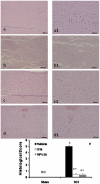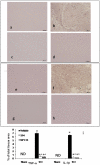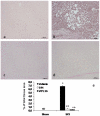PDE 7 inhibitors: new potential drugs for the therapy of spinal cord injury
- PMID: 21297958
- PMCID: PMC3031524
- DOI: 10.1371/journal.pone.0015937
PDE 7 inhibitors: new potential drugs for the therapy of spinal cord injury
Abstract
Background: Primary traumatic mechanical injury to the spinal cord (SCI) causes the death of a number of neurons that to date can neither be recovered nor regenerated. During the last years our group has been involved in the design, synthesis and evaluation of PDE7 inhibitors as new innovative drugs for several neurological disorders. Our working hypothesis is based on two different facts. Firstly, neuroinflammation is modulated by cAMP levels, thus the key role for phosphodiesterases (PDEs), which hydrolyze cAMP, is undoubtedly demonstrated. On the other hand, PDE7 is expressed simultaneously on leukocytes and on the brain, highlighting the potential crucial role of PDE7 as drug target for neuroinflammation.
Methodology/principal findings: Here we present two chemically diverse families of PDE7 inhibitors, designed using computational techniques such as virtual screening and neuronal networks. We report their biological profile and their efficacy in an experimental SCI model induced by the application of vascular clips (force of 24 g) to the dura via a four-level T5-T8 laminectomy. We have selected two candidates, namely S14 and VP1.15, as PDE7 inhibitors. These compounds increase cAMP production both in macrophage and neuronal cell lines. Regarding drug-like properties, compounds were able to cross the blood brain barrier using parallel artificial membranes (PAMPA) methodology. SCI in mice resulted in severe trauma characterized by edema, neutrophil infiltration, and production of a range of inflammatory mediators, tissue damage, and apoptosis. Treatment of the mice with S14 and VP1.15, two PDE7 inhibitors, significantly reduced the degree of spinal cord inflammation, tissue injury (histological score), and TNF-α, IL-6, COX-2 and iNOS expression.
Conclusions/significance: All these data together led us to propose PDE7 inhibitors, and specifically S14 and VP1.15, as potential drug candidates to be further studied for the treatment of SCI.
Conflict of interest statement
Figures











Similar articles
-
New methods for the discovery and synthesis of PDE7 inhibitors as new drugs for neurological and inflammatory disorders.Expert Opin Drug Discov. 2013 Jun;8(6):733-51. doi: 10.1517/17460441.2013.787986. Epub 2013 Apr 9. Expert Opin Drug Discov. 2013. PMID: 23570245 Review.
-
Effect of phosphodiesterase 7 (PDE7) inhibitors in experimental autoimmune encephalomyelitis mice. Discovery of a new chemically diverse family of compounds.J Med Chem. 2012 Apr 12;55(7):3274-84. doi: 10.1021/jm201720d. Epub 2012 Mar 16. J Med Chem. 2012. PMID: 22385507
-
PDE7-Selective and Dual Inhibitors: Advances in Chemical and Biological Research.Curr Med Chem. 2017;24(7):673-700. doi: 10.2174/0929867324666170116125159. Curr Med Chem. 2017. PMID: 28093982 Review.
-
A preliminary investigation of phoshodiesterase 7 inhibitor VP3.15 as therapeutic agent for the treatment of experimental autoimmune encephalomyelitis mice.J Chem Neuroanat. 2017 Mar;80:27-36. doi: 10.1016/j.jchemneu.2016.12.001. Epub 2016 Dec 19. J Chem Neuroanat. 2017. PMID: 28007551
-
Unleashing Spinal Cord Repair: The Role of cAMP-Specific PDE Inhibition in Attenuating Neuroinflammation and Boosting Regeneration after Traumatic Spinal Cord Injury.Int J Mol Sci. 2023 May 2;24(9):8135. doi: 10.3390/ijms24098135. Int J Mol Sci. 2023. PMID: 37175842 Free PMC article. Review.
Cited by
-
Phosphodiesterases as therapeutic targets for Alzheimer's disease.ACS Chem Neurosci. 2012 Nov 21;3(11):832-44. doi: 10.1021/cn3000907. Epub 2012 Oct 1. ACS Chem Neurosci. 2012. PMID: 23173065 Free PMC article. Review.
-
Design, synthesis, molecular docking, and molecular dynamic studies of novel quinazoline derivatives as phosphodiesterase 7 inhibitors.Front Pharmacol. 2024 Apr 22;15:1389076. doi: 10.3389/fphar.2024.1389076. eCollection 2024. Front Pharmacol. 2024. PMID: 38711988 Free PMC article.
-
Theophylline regulates inflammatory and neurotrophic factor signals in functional recovery after C2-hemisection in adult rats.Exp Neurol. 2012 Nov;238(1):79-88. doi: 10.1016/j.expneurol.2012.08.009. Epub 2012 Aug 19. Exp Neurol. 2012. PMID: 22981449 Free PMC article.
-
Role of Phosphodiesterase 7 (PDE7) in T Cell Activity. Effects of Selective PDE7 Inhibitors and Dual PDE4/7 Inhibitors on T Cell Functions.Int J Mol Sci. 2020 Aug 25;21(17):6118. doi: 10.3390/ijms21176118. Int J Mol Sci. 2020. PMID: 32854348 Free PMC article. Review.
-
Targeting Cyclic AMP Signalling in Hepatocellular Carcinoma.Cells. 2019 Nov 25;8(12):1511. doi: 10.3390/cells8121511. Cells. 2019. PMID: 31775395 Free PMC article. Review.
References
-
- Maegele M, Gregor S, Steinhausen E, Bouillon B, Heiss MM, et al. The long-distance tertiary air transfer and care of tsunami victims: injury pattern and microbiological and psychological aspects. Crit Care Med. 2005;33:1136–1140. - PubMed
-
- Bartholdi D, Schwab ME. Methylprednisolone inhibits early inflammatory processes but not ischemic cell death after experimental spinal cord lesion in the rat. Brain Res. 1995;672:177–186. - PubMed
-
- Levy ML, Chen JC, Amar AP, Yamada S, Togo K, et al. Virtual endoscopic environments in modern neurosurgical practice. Neurosurg Focus. 1999;6:e11. - PubMed
-
- Carlson SL, Parrish ME, Springer JE, Doty K, Dossett L. Acute inflammatory response in spinal cord following impact injury. Exp Neurol. 1998;151:77–88. - PubMed
-
- de Castro R, Hughes MG, Xu GY, Clifton C, Calingasan NY, et al. Evidence that infiltrating neutrophils do not release reactive oxygen species in the site of spinal cord injury. Exp Neurol. 2004;190:414–424. - PubMed
Publication types
MeSH terms
Substances
LinkOut - more resources
Full Text Sources
Other Literature Sources
Medical
Research Materials

